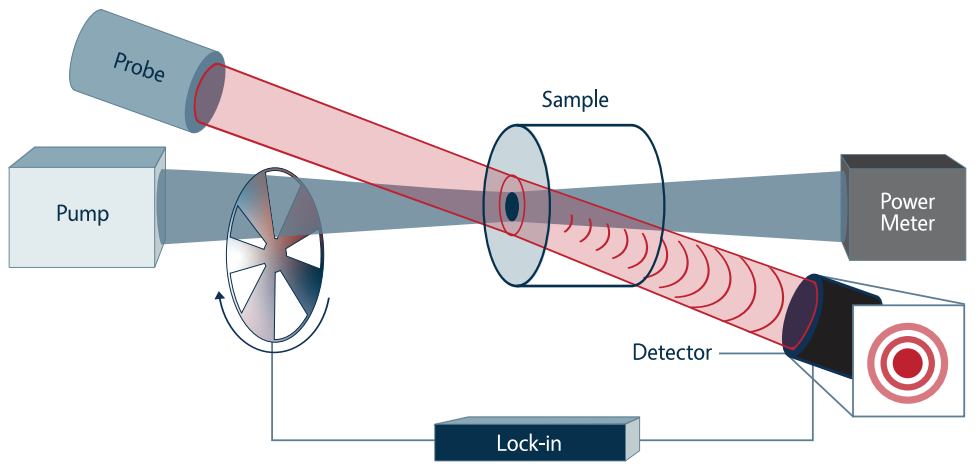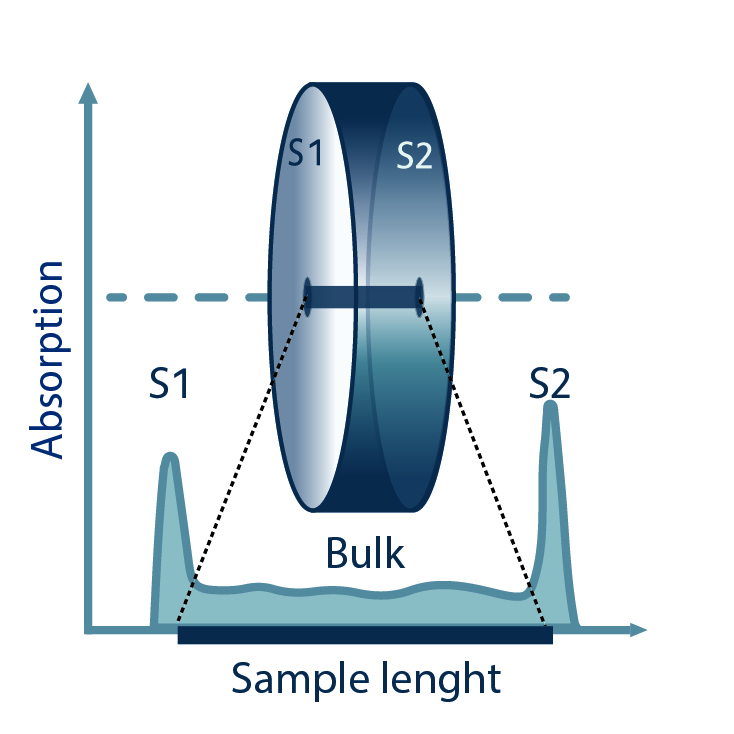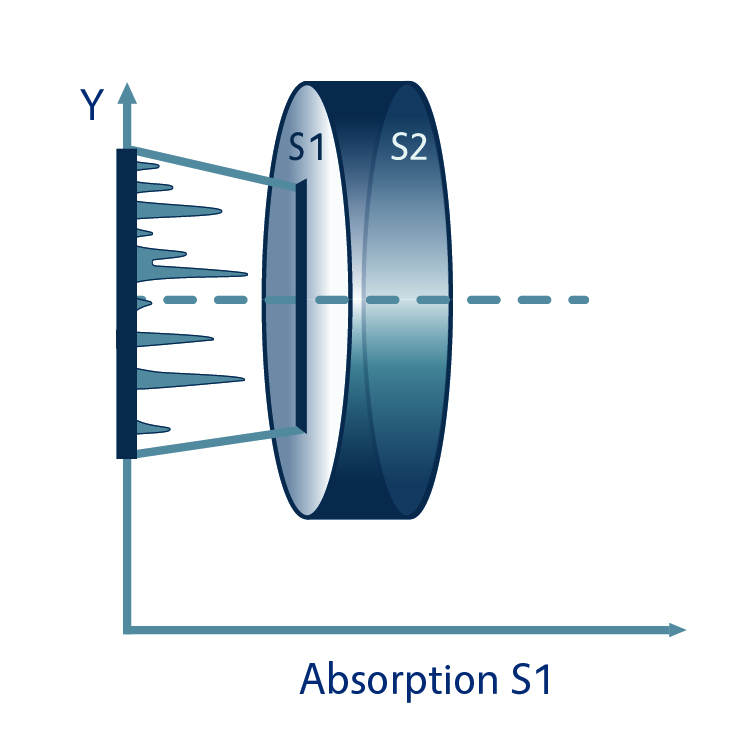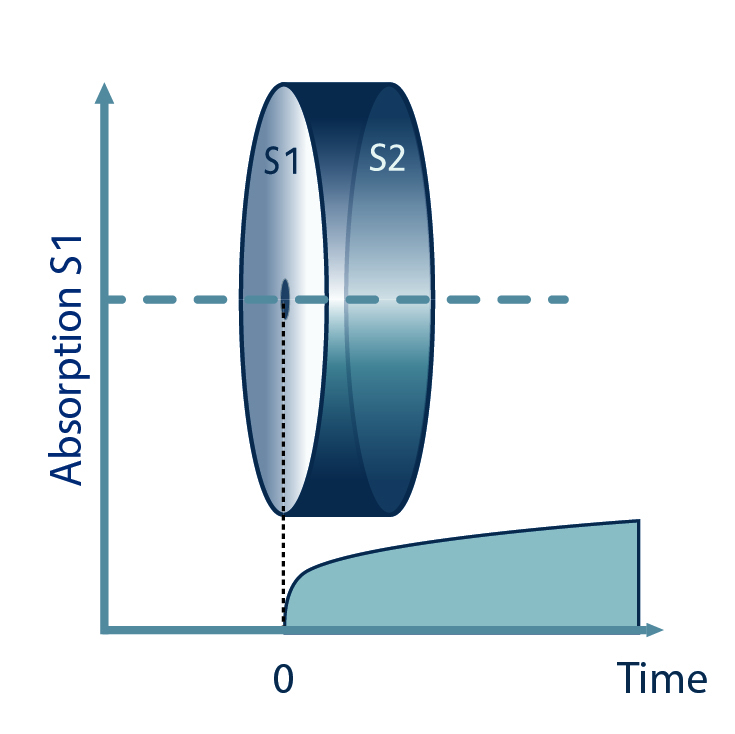
Photothermal Common-path Interferometry absorptance test on a single surface (L-Scan + T-Scan + Time-Scan)
Use this bundle for:
- To distinguish between optic ‘s front-, back-, and bulk absorption (L-Scan);
- Characterize homogeneity of absorptance of one optical surface (T-Scan);
- Characterization of absorption changes in time at a single point (Time-Scan)
- To provide “typical” absorption specifications for catalogs;
- To optimize optic’s manufacturing processes;
Test description
Photothermal Common-path Interferometry (PCI) for low absorption measurements is based on a spatially resolved pump-probe technique: a low-power probe beam senses the heating effect of an absorbed pump beam. The probe beam interferes with itself and measures the phase shift of the wavefronts. During the standard 1D absorption test, absorption is measured at multiple sites along the transverse line (of max 3mm). The standard measurement pack includes three test procedures: Transverse scan (T-Scan); longitudinal scan (L-scan) through the depth of the transparent sample and Time-scan – absorption is monitored at one site for 10 minutes.

 |
 |
 |
| Longitudinal scan (L-scan)
Absorption is measured in the |
Transverse scan (T-scan)
Absorption is measured for the |
Time scan
Absorption is measured at a |
Known limitations and risks:
- Might depend on the intensity of pump beam (nonlinear absorbance).
- Testing is available only for known calibration of substrate materials (ask for availability).
- Does not characterize absorption homogeneity over a large area.Use 2D measurement instead. Contact us to learn more about this test.
- Measurement sensitivity <1ppm could be reached but not for all samples.
- Works best for plane-parallel surfaces.
- Absorption might change with irradiation time (initial 10 min time scan is provided as standard, use long-term test for full characterization of time-dependence).
Most popular test parameters with fast turnaround
| Wavelength | Pulse duration | Repetition rate | Interested? |
|---|---|---|---|
| 1070 nm | CW | – | Order |
| 1064 nm | 10 ps | 1 MHhz | Ask for availability |
| 532 nm | 10 ps | 1 MHhz | Ask for availability |
| 532 nm | >20 ps | multi-MHz | Order |
| 455 nm | CW | – | Order |
| 355 nm | 10 ps | 1 MHhz | Order |
Testing
conditions
Related tests
Show all-
"Classical"
Lifetime TestThis test is available at ps, fs pulse duration and @kHz repetition rates: allows to investigate LIDT, ageing and lifetimeread more -
ISO 1-on-1
LIDT test (21254-1,2)Single-shot technique for determination of “intrinsic” laser-induced damage threshold of coatings.read more -
ISO S-on-1
LIDT test (21254-1,2)The most popular technique used for laser-induced damage threshold (LIDT) characterization of laser optics.read more -
Raster scan
LIDT testIt characterizes the worst-case scenario when it comes to large optics and defect-driven damageread more

Test bundles and packages
-
Find out more ›
Optics Characterization Bundle for CW regime at 1070 nm
The testing package consists of multiple tests, which are carefully selected to address optics characterization issues at the CW regime. -
Find out more ›
Lifetime + Certification Bundle for Industrial Grade fs-ps Laser Optics
The package consists of several tests carefully selected to address optics certification for critical applications.
more tools
and useful information
-
Find out more ›
Testing conditions
Check out all available laser damage testing conditions (wavelengths, pulse regimes, environments, and more). -
Find out more ›
Laser Damage infobase
Check out a useful glossary of terms and simple explanations related to the main topics of laser damage terminology. -
Find out more ›
Online Fluence calculator
Check out a calculator equipped with laser-related calculus that is frequently required in practice: such as laser fluence. -
Find out more ›
Downloads and docs
Here you can download all information about laser damage testing available at Lidaris. -
Find out more ›
New client guide
Here you will find usefull guidlines and suggestions for everyone, who is new the laser damage field. -
Find out more ›
Orders FAQ
Fast way to find out about test samples prepration, handling, and shipping.
